35th Parachute Artillery Regiment
The 35th Parachute Artillery Regiment (French: 35e Régiment d'Artillerie Parachutiste, 35e RAP) is the only airborne artillery unit of the French Army forming the air artillery component of the 11th Parachute Brigade. It is based in Tarbes together with the air cavalry, the 1st Parachute Hussar Regiment.
| 35th Parachute Artillery Regiment | |
|---|---|
| 35e Régiment d'Artillerie Parachutiste | |
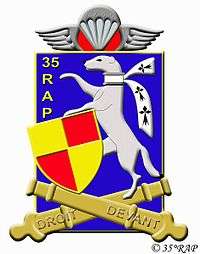 Regimental insigne | |
| Active | 1873–1942 1947–present |
| Country | |
| Type | Airborne Artillery |
| Size | 900 men and women |
| Part of | 11th Parachute Brigade 3rd Division |
| Garrison/HQ | Tarbes, France |
| Motto(s) | Droit Devant (Fr) Forward Straight Ahead (Eng) |
| Engagements | World War I World War II First Indochina War Algerian War Gulf War |
| Battle honours |
|
| Commanders | |
| Current commander | Colonel Marchand |
| Notable commanders | Ferdinand Foch |
| Insignia | |
| Insignia of the 35th Parachute Artillery Regiment | 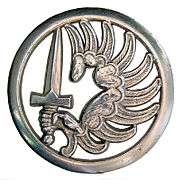 |
| Abbreviation | 35e RAP |
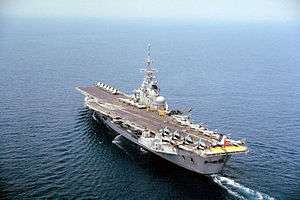
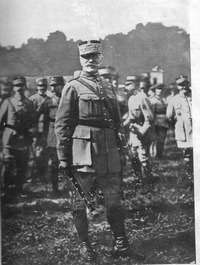
Ferdinand Foch.
History
The 35th Artillery Regiment (French: 35e Régiment d'Artillerie) was created on 7 October 1873 in Vannes and counted 9 artillery batteries equipped with 75mm cannons. The regiment was first commanded by Colonel Ferdinand Foch from 1903 to 1905; the Supreme Allied Commander on the Western Front with title bearing Généralissime (British Field Marshal, 22nd Royal First Honorary Colonel and Marshal of Poland following the war) during World War I.
World War I (1914-1918)
The regiment fought in World War I in a series of battles, receiving four citations at the orders of the armed forces. The regiment played an active role during the First Battle of the Marne. For the 35th Artillery Regiment 35e R.A, combat battles included corps-à-corps with artillerymen defending their equipment straight down to the bayonets and for which the regiment was cited at the orders of the armed forces. In 1915, the regiment took part in the Offensive of Champagne and was seen appropriated with a citation at the orders of the armed forces. On March 30, 1916, the 35th Artillery Regiment 35e R.A engaged in the Battle of Verdun for four weeks and then made way to the Battle of the Somme during the same year. In 1917, the regiment took part in numerous battles at Chemin des Dames including the Battle of La Malmaison on October 23, 1917. On March 31, 1918, the 35th Artillery Regiment 35e R.A. was found again mounting charges around artillery equipments down to the bayonets similarly to the early worst hours of 1914. For this occasion the regiment was awarded the Fourragere with colors of the Croix de guerre 1914–1918. Some of the worst hours for the regiment were endured on May 27, following which a reorganization took place 2 month later. Accordingly, the regiment participated to the final combats of the conflict. In September, the regiment supported the assault on Souin. In October, the regiment shouldered the offensive on Somme-Py.
In 1919 and with five citations at the orders of the armed forces for acts of valor, the regiment received the privilege on February 17 to bear wearing the Fourragere with ribbon colors of the Médaille militaire.
World War II (1939-1945)
During the Battle of France in 1940, two-thirds of the regiment was destroyed while covering the Dunkirk evacuation of Allied troops. The regiment was dissolved after the invasion of 1942.
At the end of the conflict, airborne artillery set foot on ground based on U.S. American models. The 20th Parachute Artillery Regiment 20e RAP, was constituted from batteries of the 20th Artillery Regiment 20e R.A and 11th Artillery Regiment 11e R.A respectively. On November 1 of 1946, the 20e RAP, was dissolved and formed two new regiments designated as the 5th Parachute Artillery Regiment 5e RAP and 6th Parachute Artillery Regiment 6e RAP. The three R.A.Ps included batteries equipped with diverse materials (wheeled cannon type 75mm, British 88mm, the U.S. cannon type 37mm anti-tank and the U.S. cannon type 75mmm) along with other anti-aircraft type equipments.[1] Accordingly, the three Parachute Artillery Regiments R.A.Ps where designated as Airborne Artillery Campaign Regiment (French: Régiment d’Artillerie de Campagne AéroPortée, R.A.C.A.P).
On May 1, 1947, was then created through a regimental organization at Tarbes, the 35th Parachute Light Artillery Regiment (French: 35e Régiment d’Artillerie Légère Parachutiste, 35e R.A.L.P)[2] from the I/35e R.A. With the newly latest formation of parachute artillery regiments, the 35th Parachute Artillery Regiment became quickly a unique type of regiment. The R.A.Ps of North Africa were dissolved in 1948 and 1949. In 1951, the regiment was equipped with several U.S. American equipment type 75 M1.A1, 75 S.R (no recoil) and the 105 HM2 series.
Indochina War (1946-1954)
The regiment fought in the First Indochina War at Dien Bien Phu within Operation Castor.
Algerian War (1954-1962)
The regiment fought during the Algerian War. With the end of the Algerian War, the regiment was repatriated to France and became part of the 11th Parachute Division.[3]
Lebanese Civil War (1975-1990)
The regiment partook in various peacekeeping missions in Lebanon on numerous yearly designated occasions, also and mainly within the ranks of the United Nations Interim Force in Lebanon, present in ground operations since 1978. From 1983 to 1984, the regiment integrated the corps of the Multinational Force in Lebanon.
Chad (1982-1990)
The regiment made an unsuccessful fire of FIM-92 Stinger during a Libyan bombardment on 10 September 19873, and on 7 July 1988 shot down a C-130 Hercules transport plane of unknown nationality in Faya-Largeau.
Gulf War (1990-1991)
The regiment was engaged in the Gulf War in 1991 part of Opération Daguet.
Foreign operations (1991-2001)
The regiment has been present around the world in Djibouti, Lebanon, Tchad, Central Africa, Gabon, Ex-Yugoslavia, Kurdistan, while also having participated in various humanitarian missions, including, Rwanda part of Opération Turquoise.
Global War on Terror (2001-present)
The regiment has been spearheading air artillery in combat, combat support, peacekeeping and multipurposed facade mission operations throughout the globe with the ongoing War on Terror, mainly on all exterior theatres of operations where the French Armed Forces are engaged in along the five continents and oceanic surroundings.
Organization
- 1 Command and Logistics Air Artillery Battery
- 1 Renseignement Air Artillery Battery
- 3 Ground-to-Ground Air Artillery Batteries
- 1 Gournd-to-Air Air Artillery Battery
- 1 Reserve Air Artillery Battery
Traditions
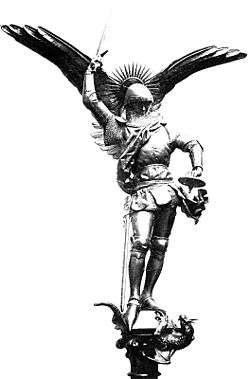
Except for the Legionnaires of the 1er REG, 2e REG, 2e REP that conserve the Green Beret; the remainder of the French army metropolitan and marine paratroopers forming the 11th Parachute Brigade wear the Red Beret.
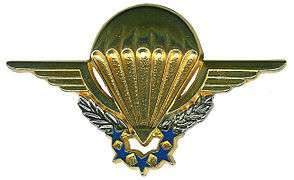
 Circled Winged Armed Dextrochere of French Army Metropolitan Paratroopers
Circled Winged Armed Dextrochere of French Army Metropolitan Paratroopers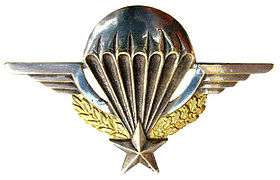
The Archangel Saint Michael, patron of the French paratroopers is celebrated on September 29.
The prière du Para (Prayer of the Paratrooper) was written by André Zirnheld in 1938.
Insignias
Just like the paratrooper Brevet of the French Army; the Insignia of French Paratroopers was created in 1946. The French Army Insignia of metropolitan Paratroopers represents a closed "winged armed dextrochere", meaning a "right winged arm" armed with a sword pointing upwards. The Insignia makes reference to the Patron of Paratroopers. In fact, the Insignia represents "the right Arm of Saint Michael", the Archangel which according to Liturgy is the "Armed Arm of God". This Insignia is the symbol of righteous combat and fidelity to superior missions.
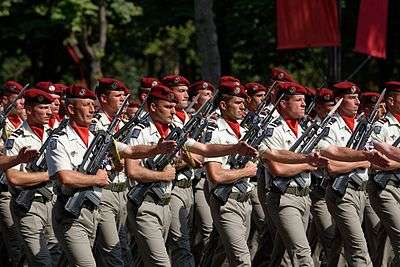
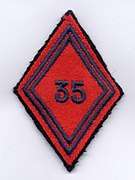
Insignia model 45 of the 35e R.A.P 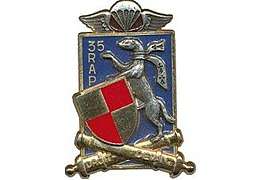
Blue Winged Rectangle with two crossed cannons reading Droit Devant topped by a red and gold shield armor 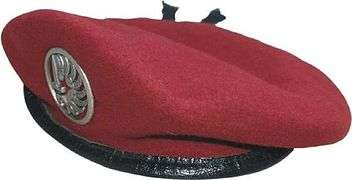
Regimental Colors
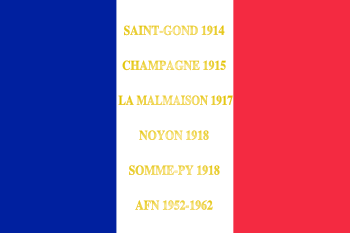
Decorations
The regimental colors are decorated with:
- Croix de guerre 1914–1918 with 4 palms cited at the orders of the armed forces.
- Cross for Military Valour with 1 palm:
- On May 21, 2012; the regiment was cited for intervention in Afghanistan within the corps of the International Security Assistance Force (I.S.A.F).
- The regiment wears the Fourragere with ribbon colors of the Médaille militaire.
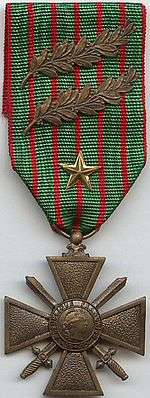
Croix de guerre 1914-1918 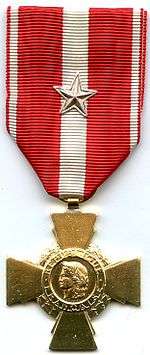
Croix de la Valeur militaire  Fourragère with ribbon colors of the Médaille militaire
Fourragère with ribbon colors of the Médaille militaire
Honours
Battle Honours
- Saint-Gond 1914
- Champagne 1915
- La Malmaison 1917
- Noyon 1918
- Somme-Py 1918
- AFN 1952-1962
Regimental Commanders
35e R.A
35th Artillery Regiment
- 1903 - 1905 : colonel Ferdinand Foch
- 1914 : colonel Ely
- 1917 : lieutenant-colonel Julliard
|
35e R.A.L.P
|
35e R.A.P
|
|
|
Gallery 35e R.A.P
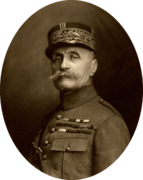 Marshal of France Ferdinand Foch
Marshal of France Ferdinand Foch
Mission Load Up 
Mali - Commando Parachute Group motorised patrol - TRF1 Cannon of a 155 mm towed by a TRM 10000.

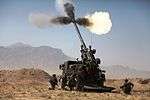
See also
References
- The early History of French Airborne Artillery (1945-1952) - Les débuts de l’Artillerie Aéroportée Française (1945-1952)
- The early History of French Airborne Artillery (1945-1952) - Les débuts de l’Artillerie Aéroportée Française (1945-1952)
- presentation organization forces artillery regiment, 35th Artillery Parachute.